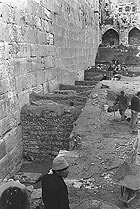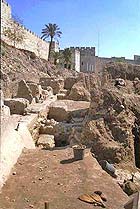State of Israel
|

|
On June 7, 1967 the Old City was conquered by the soldiers of the Israel Defense Force. With the unification of the city rehabilitation and development measures were begun in sections of the Old City under the direction of the East Jerusalem Development Company. These measures concentrated on treating and replacing the water, electric and telephone infrastructures, including the street pavement and installing proper drainage.
As part of these measures steps were taken at the end of the 1960's to treat and rehabilitate the city walls that were neglected and damaged to such an extent during the Jordanian rule that it was thought their stability had been compromised. Extensive areas were cleaned of ruins, refuse and collapse. Most of the Jordanian army positions that were on the city walls were removed. Parts of the wall were repaired and cracks were sealed. The wall was illuminated and they began repairing the city wall promenade.
Wide-ranging work was conducted in order to treat the city gates and rehabilitate them. Extensive work was done around Damascus Gate and other work, of a more limited nature was done on Herod's Gate, Lions Gate, Dung Gate and Zion Gate. At the same time archaeological excavations were begun next to the city walls, the area was landscaped, trees were planted around them and the "National Park of the Holy City" was created.
The repairs to the city walls were completed on December 19, 1969.
A series of other measures was taken during the 1980's under the direction of the East Jerusalem Development Company. As part of the project the city wall promenade was renovated, the existing pavement was treated and a number of towers were attended to along the city walls, including the tower opposite Rashadiya School (near the Rockefeller Museum), the Stork Tower, the tower opposite the Church of Saint Anne, the Sulfur Tower, the tower east of Zion Gate, the southwestern 'Corner Tower' and the towers north of Jaffa Gate. Detailed planning for these sites was prepared by the architect N. Melzer.
Extensive work was also conducted in the vicinity of Damascus Gate, the Citadel moat was treated and also Herod's Gate (other gates were not included within the framework of the aforementioned project). As part of the project to prepare the archaeological garden during the 1990's Dung Gate and the city wall in the vicinity of the Tanner's Gate were treated. A plan was also proposed for the treatment of Lions Gate but it was not implemented. Today the Old City walls are visited as one of the most important tourism sites in the Old City (Temple Mount, the Western Wall and the Church of the Holy Sepulcher). The City Wall promenade that was rehabilitated allows visitors to walk almost the entire way around the Old City on top of the ramparts.
|
|

|
| Excavations at the foot of the southern wall of the Temple Mount, 1968 |
National Photograph Collection, photographer: P. Cohen
|

|
| Excavations at the foot of the Western Wall, 1989 |
National Photograph collection, photographer: N. Alpert
|

|
| Preparing the Builders of Jerusalem Park at the foot of the Citadel and the city's western wall, 1979 |
Photographic archive of the Jewish National Fund, photographer: G. Malcolm
|
|















